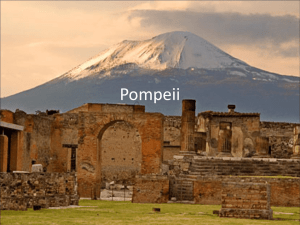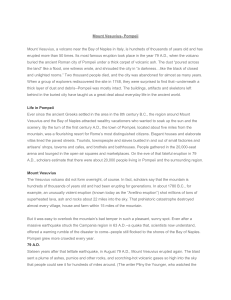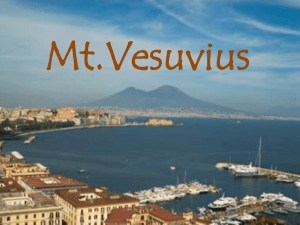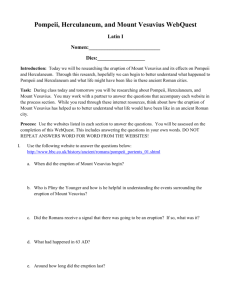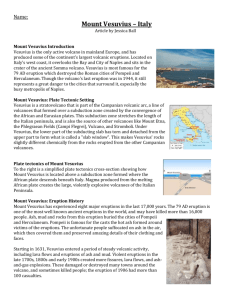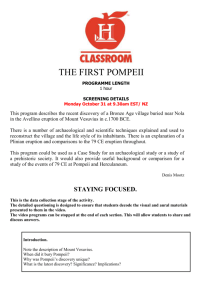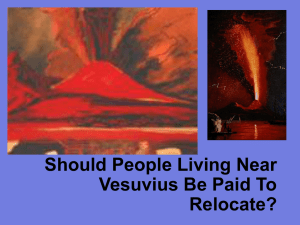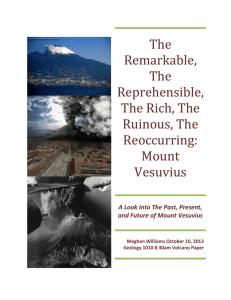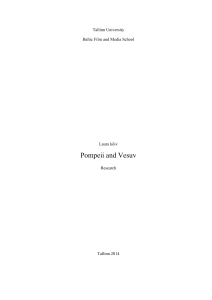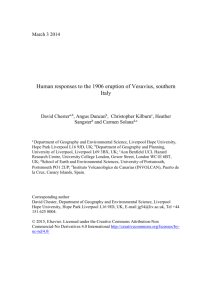Report Naples.doc - Seismology @ Fulneck School
advertisement
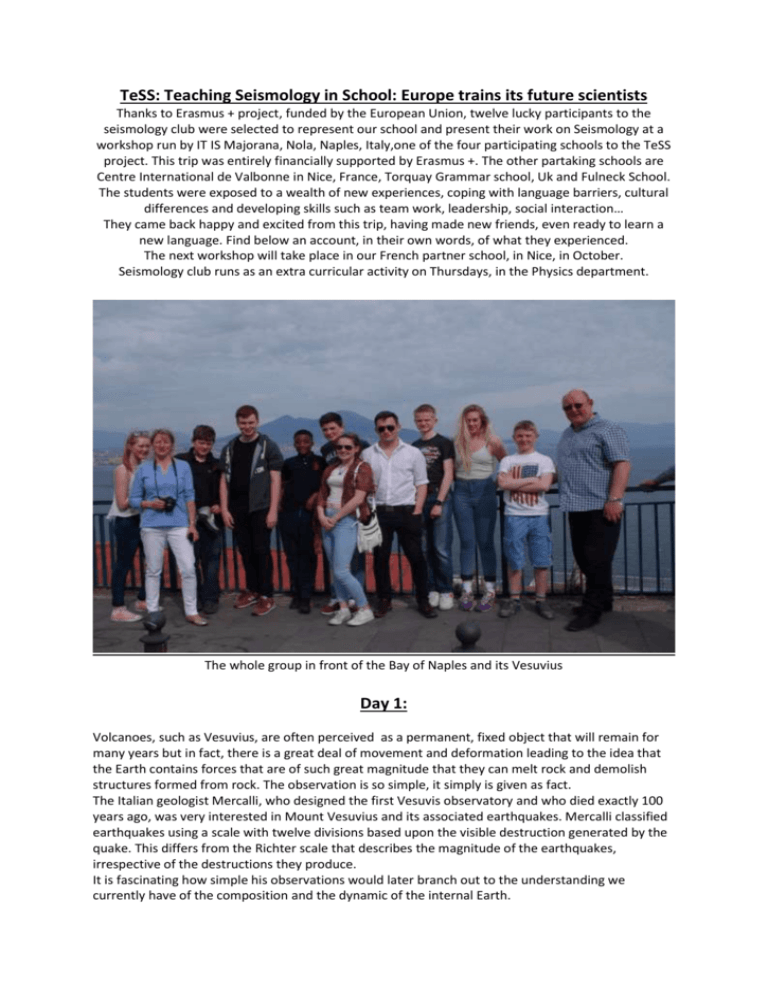
TeSS: Teaching Seismology in School: Europe trains its future scientists Thanks to Erasmus + project, funded by the European Union, twelve lucky participants to the seismology club were selected to represent our school and present their work on Seismology at a workshop run by IT IS Majorana, Nola, Naples, Italy,one of the four participating schools to the TeSS project. This trip was entirely financially supported by Erasmus +. The other partaking schools are Centre International de Valbonne in Nice, France, Torquay Grammar school, Uk and Fulneck School. The students were exposed to a wealth of new experiences, coping with language barriers, cultural differences and developing skills such as team work, leadership, social interaction… They came back happy and excited from this trip, having made new friends, even ready to learn a new language. Find below an account, in their own words, of what they experienced. The next workshop will take place in our French partner school, in Nice, in October. Seismology club runs as an extra curricular activity on Thursdays, in the Physics department. The whole group in front of the Bay of Naples and its Vesuvius Day 1: Volcanoes, such as Vesuvius, are often perceived as a permanent, fixed object that will remain for many years but in fact, there is a great deal of movement and deformation leading to the idea that the Earth contains forces that are of such great magnitude that they can melt rock and demolish structures formed from rock. The observation is so simple, it simply is given as fact. The Italian geologist Mercalli, who designed the first Vesuvis observatory and who died exactly 100 years ago, was very interested in Mount Vesuvius and its associated earthquakes. Mercalli classified earthquakes using a scale with twelve divisions based upon the visible destruction generated by the quake. This differs from the Richter scale that describes the magnitude of the earthquakes, irrespective of the destructions they produce. It is fascinating how simple his observations would later branch out to the understanding we currently have of the composition and the dynamic of the internal Earth. During the visit to the school, the Italian students were tasked with explaining the history of Mercalli and his relationship with Mt. Vesuvius. Working together: European team of students working together on designing the logo Italian students explaining Mercalli scale and his observations of volcanic eruptions and earthquakes Mercalli exposition: study of his life and achievement , led by the Italian students. The students worked in teams of five bringing members of all the participating schools to create a logo for the Erasmus+ project, the groups consisted of students from each school who chose to talk in one of the languages that all of the members knew. The knowledge of English on part of the Italian students was extremely helpful in collaborating with members of different nationalities. Google Translate was a helpful tool to help communicate. The groups designed logos and the entries were put into competition and a winner was decided on a poll basis. The winning logo of the TESS project The reward after this afternoon of work was the visit of the ruin of Villa Augusturio. The ruin that was dated from the 1st to the 5th century AD showed the architectural origins of the Italian culture but in social teams, the spectacle, I find, provides a glimpse towards the mentality of the nobles in the day. Villa Augusturio, a gigantesque excavation supported by the University of Tokyo. This structure was used by several generations and it had been partially modified to suit the later owners. The social area was divided so that part of the space was a larder and a stable, this indicates the occupants were leaning toward a more practical stance, possibly due to the tactical position of the ruin. This may have been designed to facilitate a quick escape, by process of deduction you can date when there was conflict and all of the reminisce of the modifications will have unique and intricate detail that can only be deciphered by careful deduction; an archaeological 'fly caught in amber'. The devastation caused by the eruption is countered when ash became rock and stopped oxygen causing decay of historical substances. Text by Aquila Powell Day 2 Today's activities consisted of an excellent range of programmes, starting with the brilliant hosts adapting us into their environment as they welcomed us for the second time at their school Professore Miranda welcomed us and explained the range of activities and tasks taking place today. Bianca took over providing information on their school and what it offers e.g the age ranges of students in the school and the subjects taught e.g maths, science and Italian. She also took time to explain seismic risks and teaching seismology in schools. Each school involved in the project was asked to present their school, as well as their work in their respective seismology club. Fulneck School shone as we presented our video designed by Christina, Ellis and Stephanie and on what Fulneck has to offer including our boarding facilities, culture and our Moravian heritage. This video was received with a massive round of applause from our audience. presentation afterwards comparing two of the seismometers set up in our Physics lab demonstrated by Aquilla, Daniel Newman and problems we faced installing the seismometers explained by Sonachi. Tom described the different types of earthquakes and which seismometer is more sensitive. Daniel Mohun concluded for the team. We also demonstrated our goals and aims in a This then lead onto a presentation by Nathan, Lewie, Sam and Annabelle about how they intend on teaching young pupils ages 10-11 about seismology. The French team then presented the centre International de Valbonne, a very large school with facilities such as laboratories, observatory, cinema, radio, bus stations, media library and a science/ technology park .They worked on maritime recording of earthquakes, the seismometers being located inside a buoy, called a mermaid. As they rounded up to finish it was time for the Torquay girls to present their own presentations on their school such as where they are located which is in the southwest of England. They worked on the seismic wave propagation inside the Earth. Later on, taken by the Italian students, was a talk on different types of seismic waves, such as the P wave (primary wave) and S wave ( secondary wave). We applause them due to their courage and the fact that their presentation was in a different language in which they are not use to. We concluded the morning event with a talk from a professor from Naples university on seismic risk mitigation and the development on an Earthquake Early Warning system. Text by Sonachi Obasi After a highly interesting morning, we headed for the new observatory in Naples, run by INGV, Instituto Nazionale di Geofisica e Vulcanologica. We were given a highly interesting talk about earthquakes and how they are generated I found it very interesting especially when comparing the seismic risk of Britain, France and Italy. Then we were taken to the operation room which was large with all the walls covered in monitors displaying seismic activities in Italy and its volcanoes. We listened to one of the members of staff in the operations room, manned 24 hours a day, explaining her work. After this highly educational afternoon we departed for Solfatara, which is part of a chain of 40 volcanoes, where pressures below the crust have created a convection that has deformed the rock in the ground. Then we were a lecture by an experienced tour guide who explained the vents and the gases. The smell of rotten eggs was overpowering. The guide demonstrated how ash could summon water vapour from the ground by waving a newspaper on fire. Samuel, daring to approach a fumarole. Then we saw the temple of Pozzuolli, famous for showing traces of past subsidence, because it is located on top of a magma chamber. That was very impressive. Text by Thomas Green Day Three Three days into our trip and today was jam packed with historical paradise, one was the ancient city destroyed by the eruption of Vesuvius at the same time as Pompeii called the Herculaneum and then a physically demanding short walk up to the top of the beautiful mountain Vesuvius standing high above the city of Naples. Herculaneum was destroyed by the eruption of Vesuvius in 79 AD which covered it with an impressive amount of mud, ash and other eruptive materials from a pyroclastic flow which is 600 degrees Celsius and travels at 90 mph consumed the town, at a depth of 16 metres. Then rainwater mixed with the materials and solidified the mud, preserving many of the cities wonders in time. The preservation of a huge amount of furniture, mosaics and paintings shows us what the culture of the people in the 1st century was like and gives us an idea of how they lived daily life. Located below the current city, Herculaneum was buried by 16 m of ash during the 79AD eruption The remains of the former inhabitants who had seek refuge in boat house, hoping to escape by see..only to suffocate and die from the pyroclastic flow. Four years before the eruption part of the city was destroyed by an earthquake, but then filled in by the pyroclastic flows that covered the city, since then large amounts of excavation. I felt that this is more interesting than Pompeii because it is better preserved, which allows you to experience their life and culture. It isn't as large as Pompeii, making it less impressive. Later we travelled to Mount Vesuvius. We began to climb, it was very difficult as the volcanic rock made it a lot of effort to climb up. If you take one step you slide back a bit. This made it very difficult. After a further 30 minutes of intense walking, we were finally at the top of this deadly volcano. We could not take very good pictures, due to the then cloud cover. We stayed at the top of the volcano for about 20 minutes, we started to travel back to the coach. There were several trips and slips. Yet we managed unharmed. When we arrived at the bottom, we had some free time. Several students stopped and bought souvenirs. We then left for the coach, and was quickly on our way. We first had to drop of the Italians, before heading back to the hotel, where we went to the shops and swam in the swimming pool. We had a delicious dinner before bed. Text by Daniel Newman Day 4 On the Sunday of our trip, we ventured around Napoli, the heart of Naples. We walked down the typical narrow streets and visited the sights. One was Il Diuomo Cattedrale Di Napoli, which is a delicately sculpted cathedral. With high ceilings and beautiful antique paintings, it truly was a spectacular sight. After a short walk around the busy streets of Napoli, we were left to explore out on our own. We looked around the city in small groups. Naples is known for its leather so we saw many stalls and shops selling wallets, belts and woven bracelets. It is also known for its food. We sampled local delicacies like fried pizza and chocolatey treats. The famous dome of Il Duomo Now, of course, you can't come to Italy without some good old fashioned Ice cream. Mr Harrison led the group to find a suitable ice cream parlour. As a group we came to a conclusion: Italian food is awesome. We went on a bus tour around the city. The bus driver showed us some of the most beautiful sights in Naples which really were breathtaking. We stopped for photo opportunities and took massive group photos. When we came back to the hotel we all relaxed around by the pool. After dinner the French girls set up a disco for all of us. Overall it was quite a good day! Text by Stephanie Harrison and Christina Pullin Day 5 In our fourth day we travelled to Pompeii by coach. When we got there, we shared a guide with the Torquay girls and she was very good – her English was perfect and her knowledge was amazing, she was able to answer all our questions! We started outside the city walls, on an old road lined with the ruins of the tombs (mainly the noble families of Pompeii). It was very impressive and you could also see the names of the families the tombs belonged to. Alongside this, she showed us the deposits of the pyroclastic flow with distinct layers that geologists use to reconstruct the eruptive activity of Vesuvius. We entered the city to a magnificent sight- a large amphitheatre which is the oldest one in the world dating back to 89 B.C. Here we learnt this is where the gladiators battled to death in a bloody fight in front of hundreds of people. Gladiators were originally slaves and they were forced to do fight even though many times it resulted in death. Moving onward, we saw something amazing and extremely touching; the plaster casts of those who died in the eruption of 79 A.D. The archaeologists were able to make these because the city was covered in ash not lava. The ash settled around the people encasing them in a stone like substance as they were living and moving. Due to this, and the flesh decomposed and left the bones, the original position of a person’s death was literally frozen in time. It was amazing to see, but also extremely sad because there were young children and a man whose facial expression was perfectly preserved. As we walked through the main streets we came to a spectacular large house with beautiful gardens. It was the house of what we would call in these days a politician. As you passed through the city, you could see graffiti on the walls of his name as propaganda for the last election that occurred in the March before the eruption. It was amazing to think that they were this democratic - just like we are nowadays. As we passed the shops and houses of the 'plebs' (poorer people of Pompeii) we came to a large opening known as the plaza. You could see temples of the gods and old pottery. The floor was originally covered in marble but only a few stones of this remained. At the time of the eruption the plaza was actually undergoing restoration because of the earthquake that happened in 69 A.D. This was a pre-warning sign that the eruption was coming, but people living in Pompeii believed it was the gods who were angry at them. Due to seismology nowadays we know different. This led us to the end of the tour. Pompeii was amazing. Text by Annabelle Swift and Ellis Lill

